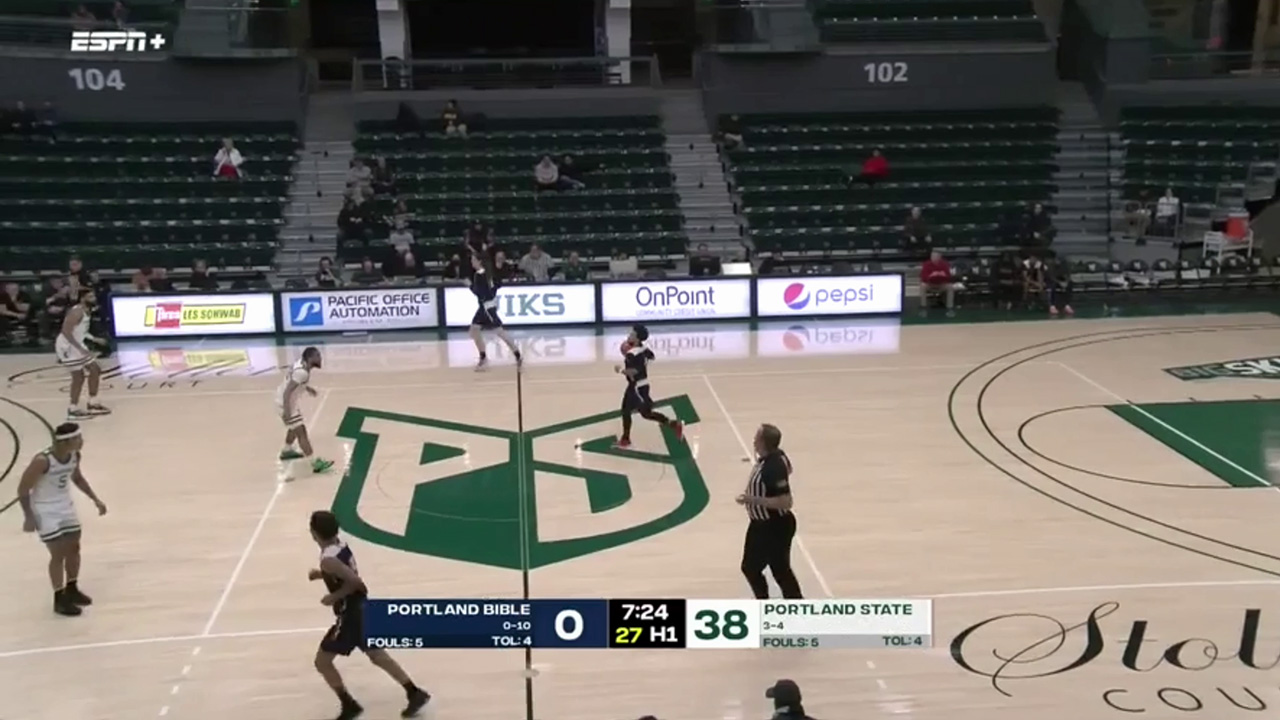In a meeting of church and state, the state laid down the hammer last night.
Portland State is a member of the Big Sky Conference. The Vikings men’s basketball team is just 4-4 this season, but has already beaten Oregon State twice. Last night the Vikings played Portland Bible College, a member of the National Christian College Athletic Association’s Division II. The school is run by the non-denominational Christian megachurch Mannahouse and only grants religious degrees. The most recent enrollment figure I can find is from a decade ago, when the school had 415 students. The basketball team last night had just six players on it.
The game somehow went even worse than you’d expect. Portland State scored the game’s first 38 points, led 63-9 at halftime and beat up the Arrows 114-31. “The winning margin was not the highest in school history, nor was the opponent point total the lowest,” the Portland State team website notes. Portland State did fall six points short of the most consecutive points to start a game; Southern scored the first 44 points in a 116-12 win over Champion Christian College in 2013.
There will always be basketball mismatches and lopsided scores. But this was quite the one-sided affair even by those standards. These types of games are happening a bit more as NCAA Division I basketball teams realize that scheduling non-Division I opponents can benefit them in many ways. Ken Pomeroy, basketball stats guru and friend of Defector, was nice enough to share this chart.
| Season | Non D-I Games | All Games | Percentage |
|---|---|---|---|
| 2003-04 | 297 | 4,634 | 6.4 |
| 2004-05 | 305 | 4,732 | 6.4 |
| 2005-06 | 294 | 4,790 | 6.1 |
| 2006-07 | 329 | 5,105 | 6.4 |
| 2007-08 | 311 | 5,208 | 6 |
| 2008-09 | 317 | 5,269 | 6 |
| 2009-10 | 366 | 5,361 | 6.8 |
| 2010-11 | 354 | 5,336 | 6.6 |
| 2011-12 | 357 | 5,346 | 6.7 |
| 2012-13 | 340 | 5,396 | 6.3 |
| 2013-14 | 425 | 5,513 | 7.7 |
| 2014-15 | 426 | 5,502 | 7.7 |
| 2015-16 | 428 | 5,516 | 7.8 |
| 2016-17 | 436 | 5,542 | 7.9 |
| 2017-18 | 458 | 5,572 | 8.2 |
| 2018-19 | 445 | 5,617 | 7.9 |
| 2019-20 | 437 | 5,609 | 7.8 |
| 2020-21 | 335 | 3,919 | 8.5 |
| 2021-22 | 488 | 5,536 | 8.8 |
| 2022-23 | 497 | 5,805 | 8.6 |
There is a reason for that bump in the last two years: When a game was canceled due to COVID, a non-Division I team was often there to step in as a fill-in opponent. But that total has not gone down this year, despite the lack of COVID cancellations so far. In 2004, per Pomeroy’s numbers, 297 of 4,634 games featured a Division I team versus a non-Division I team (6.4 percent). This year it’s 497 of 5,805 games (8.6 percent). That’s 200 more games per season!
It makes sense for an NCAA Division I team to schedule games against schools from lower levels. If a top-conference program plays a middling school, that game usually hurts the top school even if they win by 100. Hurting the strength of schedule hurts the computer numbers, which can hurt the chances of getting into the NCAA tournament or getting a favorable seed.
But a game against a school that isn’t one of Division I’s 363 programs does not really count, in essence. Schools are even allowed to exempt certain games against non-Division I teams from its maximum number of allowed games. Unlike when a good team plays a bad team within Division I, this kind of game does not really hurt the perception of the good team. The games don’t count in any of the numbers the NCAA tournament selection committee uses. But the school gets to beat up on a low-level opponent, its players can pad their personal stats, and the team isn’t really punished in anything but embarrassment if it happens to lose. (The games usually aren’t counted for the non-Division I school in its standings or statistics. “I suspect that wrinkle has statistical justification as well,” Pomeroy wrote in 2016. “Illinois Tech would be less likely to play Chicago State if the Scarlet Hawks knew that the 137 points they gave up would be included in… statistical rankings.”)
There are some rules around this from the NCAA and conferences. The West Coast Conference, for example, says schools can only play two games against non-Division I opponents. The NCAA has specific guidelines about what is a “countable opponent”: It has to be a four-year degree-granting institution, it has to have a varsity team and it needs to be accredited by one of a number of academic governing bodies. The NCAA even publishes a list of schools that don’t count if a team were to play them. For example, NCAA teams cannot currently count games against Holy Patriot University (Beaumont, Texas), Justice College (Chandler, Ariz.), Forest Trail Sports University (Concord, N.C.) or the University of God’s Chosen (Fayetteville, N.C.), because the NCAA says they do not meet accreditation or membership requirements.
The experience isn’t so bad for the lower-division team, either. Their kids get pounded, sure, but they also get to play at a Division I gym. Sometimes the lower-level teams get better, too! Southern played Champion Christian College again earlier this week, and only won 112-52.
In 2017, Penn played Penn State Brandywine, a school that competes in a league comprised of Penn State extension campuses. I wrote about it for a certain website because there was a cheesesteak-related game subplot. That article led to my father, who played for Penn State Brandywine in the 1970s, when it was called Penn State Delco, throwing up an “honorary first tip” at a Penn State Brandywine game the next year. At that game I talked to Brandywine’s coach, who gushed about what a great experience it was for his kids to play a Division I school and, presumably, get written about on the old version of that website.
That game ended with a 99-40 victory for Penn. It was the biggest win in school history. Penn went on a 44-3 run at one point. It was a rout. But it was not the Portland State-Portland Bible matchup. Brandywine had a full lineup. Portland Bible had six players. There is a limit to all this, and the Portland Bible Arrows may represent it.
The Arrows have lost five games by 70-plus points this year; their closest loss was an 85-41 pounding against NCAA Division III Willamette. The AP says they are now 0-11. (Would you update your official team website after this start to the season?) Their computer ratings from Kenneth Massey are really poor. “Massey only has community colleges rated below them,” Pomeroy wrote to me in an email.
There may be bigger things on the way for Portland Bible—just not in basketball. It’s right in 1 Corinthians chapter 9, verse 25: “Everyone who competes in the games goes into strict training. They do it to get a crown that will not last, but we do it to get a crown that will last forever.”






